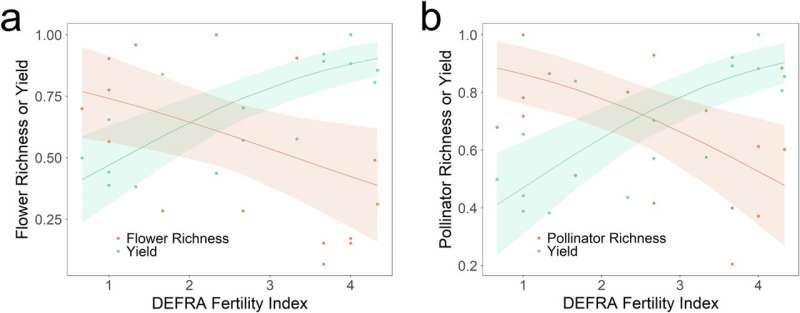https://phys.org/news/2025-02-grasslands-fertilizer-drastically-insects.html
By Tom Walters, University of Sussex February 3, 2025

Trade-off between flower and pollinator species richness and grassland yield. Credit: npj Biodiversity (2025). DOI: 10.1038/s44185-024-00070-6
A new study by researchers at the University of Sussex and Rothamsted Research published on Jan. 20 in npj Biodiversity has revealed the devastating impact that increased fertilizer use has on agricultural grasslands.
The researchers examined the role of soil fertilization on the diversity and number of pollinators and flowering plants at the world’s longest-running ecological experiment, Park Grass, Rothamsted, set up nearly 170 years ago, in 1856.
Their findings show that increasing application of fertilizers such as nitrogen, potassium and phosphorus, can reduce flower numbers five-fold and half the number of pollinating insects in agricultural grasslands.
This is a critical moment for land use policy globally, with many countries, including the U.K. and the European Union, currently undertaking significant green reforms of their agricultural policies.
Almost a quarter of the Earth’s land area and almost half of the U.K. is agricultural grassland, areas where grasses or grass mixtures are used to feed livestock, support wildlife and maintain land resources in good condition. Fertilization of these areas has boosted food production but has come at the cost of environmental degradation and adverse effects on human health and welfare.
Dr. Nicholas Balfour, post-doctoral researcher at the Laboratory of Apiculture and Social Insects at the University of Sussex, said, “Our results show significant biodiversity benefits from reducing fertilizer in agricultural grasslands.
“While reduced yields are not typically thought of as a good thing, reducing grassland production intensity has the potential to realize many of the benefits of a multifunctional landscape: benefiting pollinators, increasing resilience to extreme weather events, increased natural pest control, better soil health and air quality, and reduced soil erosion.
“Our study suggests that the subsidies proposed in the forthcoming agricultural reforms are an economic necessity for sustainable and considered land stewardship that reduces fertilizer application and limits its negative consequences for biodiversity.”
Dr. Balfour, Ciaran Harris and Professor Francis Ratnieks of the University of Sussex conducted a field study in Hertfordshire, England where they quantified and identified the flowering plants and the insect pollinators (bees, wasps, flies etc.) present across 18 paired fertilizer treatments at Park Grass.
They found that reducing fertilizer application increased the numbers, species richness and functional diversity of both flowers and pollinating insects.
They also identified a trade-off between flower and pollinator diversity and grassland yield. To maximize flowering plant species richness, and hence also pollinator species richness, a significant drop in fertility is required—but this will reduce yields.
However, the study did identify a potential solution by looking at fertilizer adjustments. Their findings revealed that fertilizing plots with all the major plant nutrients except nitrogen encouraged a high proportion of leguminous species. This approach not only preserved yields but also supported a greater number of pollinators, including bees. This could be a possible solution for conflicted landowners.
Bottom of Form
Professor Ratnieks, emeritus professor of apiculture at the University of Sussex, said, “I visited Park Grass many years ago and realized the unique opportunity it provided to study the effect of fertilizing grasslands on wild flowers and bees. Considering the current focus on fertilizer use, and the substantial declines in pollinator numbers over recent years, this study could not have come at a better time, as we seek to understand how landowners can best help bees and other pollinators through open grassland areas.”
The authors’ findings highlight the challenge of balancing competing priorities in farmland management. They emphasize the importance of financial incentives to help with yield losses and enhance biodiversity in agricultural grasslands. Achieving these benefits will require well-crafted policies that promote the sustainable stewardship of pastoral landscapes.
More information: Nicholas J. Balfour et al, Trade-off between pollinator-wildflower diversity & grassland yields, npj Biodiversity (2025). DOI: 10.1038/s44185-024-00070-6
Provided by University of Sussex